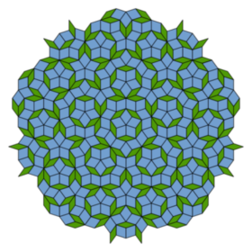Description
 A tiling is (most typically) a way to partition the infinite 2D plane using many copies of a few shapes. Ordinary tilings are periodic; they repeat themselves. This is how we know a tiling could cover the plane, although we can only see a finite part of it.
A tiling is (most typically) a way to partition the infinite 2D plane using many copies of a few shapes. Ordinary tilings are periodic; they repeat themselves. This is how we know a tiling could cover the plane, although we can only see a finite part of it.Penrose tilings, on the other hand, do not repeat in a regular way. But if we define carefully how to construct them (and there are very different ways to do this) we can still be sure that they extend to cover the plane, and we can still find different kinds of regularities and repetitions; for example, Penrose tilings are self-similar, like fractals.
The Fibonacci numbers, and the golden ratio (the "most irrational number") are important in Penrose tilings, so you could look into them. You could also investigate other kinds of non-periodic tilings.
Prerequisites
No particular topic in maths beyond 1H level is required.Resources
- Wikipedia provides a comprehensive introduction to Penrose Tilings, and lots of links.
- Mathworld also has good links.
- A pair of nice introductory articles here and here
- There are even some animations on Youtube
- Wikipedia is a starting point for other non-periodic tilings too.
- "Tilings and Patterns" by Grunbaum and Shepherd covers lots of background ideas.
- "Quasicrystals and Geometry" by Marjorie Senechal looks at Penrose Tilings in several ways.